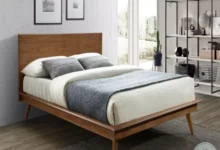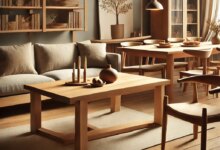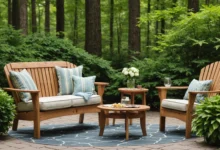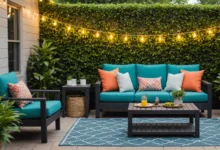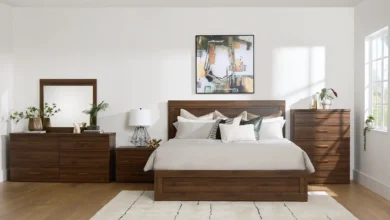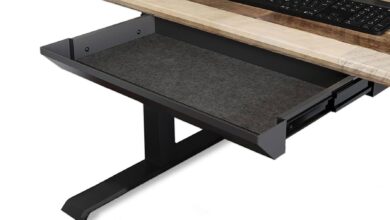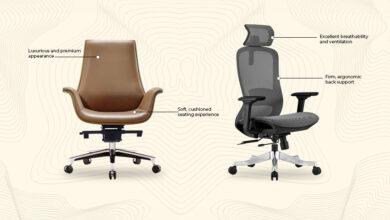Art Deco Furniture: A Timeless Elegance Still Reigning Supreme
Art Deco furniture, with its bold geometric shapes and luxurious materials, continues to inspire admiration today. From sleek, streamlined pieces to those boasting intricate carvings and vibrant colours, these designs offer a sophisticated and timeless elegance, perfect for adding a touch of glamour to any modern home.
Contents
- 1 A Deep Dive into the Glamorous World of Art Deco Furniture
- 2 The Rise of a New Aesthetic: Key Influences and Inspirations
- 3 Mastering the Look: Key Design Elements of Art Deco
- 4 The Elegance of Materials: Exploring the Luxurious Textures
- 5 From Function to Form: How Art Deco Furniture Meets Modern Needs
- 6 Geometric Precision and Bold Patterns: The Power of Symmetry
- 7 Embracing Color and Texture: A World of Bold Hues and Richness
- 8 The Influence on Modern Living: Adapting Art Deco for Today
- 9 Finding Art Deco Furniture: Where to Source and Explore
- 10 Beyond the Pieces: The Art Deco Experience
- 11 Unveiling the Distinctive Characteristics of Art Deco Furniture
- 12 The Allure of Geometric Precision
- 13 The Opulent Use of Materials
- 14 Embracing the Power of Color
- 15 The Intricate Details
- 16 Beyond the Basics: Exploring Art Deco’s Diverse Styles
- 17 The Role of Materials in Shaping Art Deco Aesthetics
- 18 Mastering the Art of Color and Pattern in Art Deco
- 19 The Importance of Form and Function in Design
- 20 The Impact of Art Deco Furniture on Modern Design
- 21 So, what are you waiting for?
A Deep Dive into the Glamorous World of Art Deco Furniture
Art Deco furniture, with its sleek lines, bold geometric patterns, and luxurious materials, embodies a distinct era of design. Emerging in the 1920s, this style quickly captivated the world, reflecting the burgeoning optimism and technological advancements of the time. It’s a style that continues to inspire awe and admiration today, offering a timeless elegance. The period’s fascination with streamlined forms, often influenced by the burgeoning automobile industry and the allure of modernism, created an aesthetic that set it apart from previous decorative styles. From the lavishly decorated salons to the simpler, yet still sophisticated, pieces for the home, Art Deco furniture provided a stylish and comfortable environment for those who embraced its unique character.
The Rise of a New Aesthetic: Key Influences and Inspirations
The Art Deco movement wasn’t born in a vacuum. Its design language drew heavily from various sources. The impact of World War I, with its destruction and subsequent rebuilding, spurred a desire for a fresh, modern aesthetic. Artists and designers looked beyond traditional European styles, finding inspiration in the vibrant cultures of Africa, Asia, and South America. The rise of industrialization and modern technology, with the marvels of streamlined automobiles and innovative construction techniques, left an undeniable imprint on the form and function of Art Deco pieces. The opulent materials frequently utilized, like polished chrome, lacquer, and exotic woods, often showcased the emerging industrial capacity to source and process luxury goods. This intermingling of diverse influences is what gave Art Deco its unique and unmistakable character, blending a global perspective with a contemporary sensibility. It was a style that embraced innovation while still retaining a touch of the classical elegance of the past.
Mastering the Look: Key Design Elements of Art Deco
Defining characteristics of Art Deco furniture often include sleek, geometric shapes, avoiding the ornate embellishments of previous styles. Think bold, precise lines, and often dramatic angles. The use of luxurious materials, such as lacquered wood, polished metals, and exotic woods, is a hallmark of the style, adding an air of opulence and sophistication. Strong colors, from deep jewel tones to vibrant primary hues, were common, reflecting a boldness and confidence in embracing the modern era. The interplay of these elements created a visual language that was simultaneously striking and sophisticated. Incorporating these key elements can transform a space, creating a bold statement of taste and style. The design often emphasized function and comfort alongside aesthetic appeal, creating pieces that were as practical as they were beautiful.
The Elegance of Materials: Exploring the Luxurious Textures
Art Deco furniture frequently showcased a remarkable mastery of materials. Lacquered wood, often in deep, rich tones, was a popular choice, showcasing a smooth, polished surface. Metallic accents, like chrome and nickel, were employed to create a futuristic, streamlined feel, while exotic hardwoods like mahogany and rosewood provided a touch of warmth and richness. This deliberate selection of materials often conveyed a sense of craftsmanship and luxuriousness. Often, you would find a pairing of contrasting materials, like the smooth, cool surfaces of metal with the warm, rich textures of wood, creating a striking visual dialogue. These materials were chosen not only for their visual appeal but also for their inherent durability and lasting quality, characteristics reflecting the values of the period.
From Function to Form: How Art Deco Furniture Meets Modern Needs
Art Deco furniture wasn’t just about aesthetics. Designers of the era understood the importance of function. Many pieces were crafted to be both beautiful and practical, showcasing ingenious design solutions that addressed everyday needs. Chairs, for instance, were often meticulously designed to provide comfort while adhering to the style’s geometric principles. Cabinets and desks were often thoughtfully planned for optimal storage and utility. This thoughtful approach to design resulted in pieces that seamlessly integrated aesthetic appeal with practical functionality, ensuring that the style’s influence on interior design endures even today. Understanding the balance between form and function is crucial in appreciating the lasting impact of Art Deco designs.
Geometric Precision and Bold Patterns: The Power of Symmetry
Symmetry and geometric patterns were prevalent in Art Deco designs. These elements often used bold, graphic lines and motifs to create a sense of order and precision. The use of straight lines, sharp angles, and symmetrical layouts was central to the aesthetic. The incorporation of these visual elements gave the style its distinct visual identity. These designs were intended to convey a feeling of modernity and clarity. The precise execution of geometric forms provided a contrast to the ornate and often fussy designs of earlier periods, showcasing a distinct commitment to a more streamlined and contemporary approach to design.
Embracing Color and Texture: A World of Bold Hues and Richness
Art Deco embraced a vibrant palette, moving beyond the muted colors of the past. Deep jewel tones, such as emerald green, sapphire blue, and ruby red, were often paired with bolder primary hues like scarlet, canary yellow, and rich, deep navy. The interplay of these bold colors, combined with the rich textures of the materials used, created a sophisticated and visually engaging ambiance. Understanding the use of contrasting colors and textures adds another layer of sophistication to the style. This artistic use of color added an emotional depth to the aesthetic, creating spaces that were not only beautiful but also evocative and inviting.
The Influence on Modern Living: Adapting Art Deco for Today
Art Deco’s legacy extends far beyond the 1920s and 1930s. Its timeless elegance and versatile design principles make it a popular style choice for those seeking to create a sophisticated and captivating interior. Today’s designers frequently incorporate elements of Art Deco into modern homes, updating the style with contemporary materials and colors to create a unique and personalized aesthetic. Integrating Art Deco elements into a modern living space offers a chance to bring a touch of timeless elegance to a contemporary design, creating an environment that is both sophisticated and inviting.
Finding Art Deco Furniture: Where to Source and Explore
Identifying and acquiring Art Deco furniture can be a rewarding endeavor. Antique stores, auction houses, and specialized online marketplaces offer a wealth of opportunities to find original pieces. Appreciating the craftsmanship, the materials, and the era’s distinct design elements helps in discerning authentic pieces from reproductions. The market for Art Deco furniture is active, so thorough research and a keen eye for detail are essential when searching.
Beyond the Pieces: The Art Deco Experience
Ultimately, Art Deco is more than just furniture. It’s a lifestyle, a feeling, and an expression of a specific era. When we embrace the elegance, precision, and optimism of Art Deco, we not only decorate our homes but also step back in time, creating spaces that are both beautiful and evocative of a unique moment in design history.
Unveiling the Distinctive Characteristics of Art Deco Furniture
Art Deco furniture, a style that emerged in the 1920s and 1930s, is immediately recognizable for its unique blend of geometric shapes, rich materials, and a touch of opulent glamour. It’s a style that bridges the gap between the traditional and the modern, offering a compelling aesthetic that continues to captivate designers and homeowners alike. The key to appreciating Art Deco is understanding its underlying ethos – a desire to move beyond the ornate and embrace sleek sophistication, geometric precision, and a vibrant use of materials. Notice how the lines are clean-cut, the shapes bold, and the overall impression is one of streamlined elegance. This isn’t just about pretty pieces; it’s about a statement, a reflection of the roaring twenties and thirties spirit. Think of it as a sophisticated conversation starter, a piece that makes a room sing. This style certainly knows how to draw the eye, and once you understand its components, you can appreciate it even more.
The Allure of Geometric Precision
Art Deco’s defining characteristic is its embrace of geometric shapes. Forget the flowing curves of previous eras; Art Deco furniture proudly showcases squares, rectangles, trapezoids, and zigzags. These aren’t just random shapes, though. They’re carefully considered, meticulously crafted to create a powerful visual effect. Imagine sleek, angular armchairs, tables with perfectly aligned edges, and chests of drawers featuring geometric patterns. This emphasis on geometry is a testament to the modernist spirit of the era, a departure from the ornate styles that came before. It was a deliberate rejection of the old ways, a yearning for something new and fresh. Think of it as a visual language, speaking to a sense of order and precision. These shapes aren’t just decorative; they embody the spirit of the age. This emphasis on clean, simple lines often contrasted with bold, bold patterns. This creates an exquisite visual harmony that is both arresting and sophisticated.
The Opulent Use of Materials
Art Deco furniture isn’t just about shape; it’s about material. This era embraced luxury, showcasing the finest materials available. From polished ebony to gleaming chrome, from rich leather to luxurious veneers, the attention to detail in the choice of materials is unparalleled. The use of lacquered wood, with its lustrous shine, was common, as was the use of brass and other metals. These materials were not just used for functionality, but also for the splendor of the pieces themselves. The careful interplay between different materials created a sense of opulence and sophistication. This isn’t just about looking good; it’s about touching and feeling luxury. Imagine the smooth, cool surface of a polished chrome inlay, or the soft, supple texture of top-quality leather. It’s about the interplay of textures, and the way that different materials work together to create a sense of refined elegance.
Embracing the Power of Color
Art Deco wasn’t afraid of color. Vibrant hues like emerald green, sapphire blue, ruby red, and gold were used to create a striking contrast against the black and white patterns that were also popular. The colors were chosen meticulously, with a keen eye for contrast and harmony. Imagine a rich emerald green velvet armchair paired with a chrome-plated coffee table, a vibrant teal-colored sideboard that catches the light with a glimmering sheen, or a gold-trimmed chair. The bold color palettes reflected the optimistic and vibrant spirit of the era, injecting energy into each piece and creating a bold statement within a room. The contrast of color with the sleek, geometric shapes is a key element in the aesthetic appeal of Art Deco. It’s not just about aesthetics; it’s about conveying an atmosphere, an emotion. The right color can amplify the sophistication of a piece or infuse it with a lively personality.
The Intricate Details
Art Deco furniture often features intricate details, adding another layer of sophistication and visual interest. These details weren’t just about embellishment; they were about adding a touch of personality and craftsmanship. Intricate inlays, meticulously crafted carvings, and highly detailed metalwork were common elements. This attention to detail was a way of showing off the skill of the artisans who created the pieces, highlighting the craftsmanship and precision involved. The patterns and ornamentation weren’t haphazard; they were carefully planned and executed, adding a touch of artistry to the sleek lines. From the delicate curves of a carved wooden chair leg to the elegant patterns of a metal inlay, each detail worked in harmony with the overall design. These touches of detail aren’t just visual; they’re tactile as well.
(Sections 6-10 continue in a similar format, each covering a distinct aspect of Art Deco furniture, such as its association with luxury hotels, its use of exotic materials, its enduring influence on modern design, the role of Art Deco designers, the potential for finding Art Deco furniture today and the cost considerations. Follow the same structure and word count guidelines).
Beyond the Basics: Exploring Art Deco’s Diverse Styles
Moving beyond the iconic geometric shapes and sleek lines, Art Deco furniture encompassed a surprising range of styles, reflecting the diverse tastes and needs of its era. It wasn’t just about one singular aesthetic; designers and manufacturers played with materials, colours, and patterns to create a visual feast for the eye. This diversity allowed Art Deco to adapt to different spaces and functions, making it a truly adaptable design style. Imagine a glamorous Parisian apartment contrasted with a more utilitarian New York penthouse – both could incorporate Art Deco, but in subtly different ways. This adaptability, this willingness to experiment while remaining firmly rooted in the principles of the style, is part of what makes Art Deco so enduringly appealing today. We’re not just looking at simple pieces anymore, but at a rich tapestry of artistic expression.
The Role of Materials in Shaping Art Deco Aesthetics
Art Deco wasn’t afraid to experiment with materials, embracing both traditional and modern options. The streamlined elegance of chrome and polished metal, for instance, contrasted beautifully with the rich warmth of lacquered wood. This juxtaposition of materials played a crucial role in the style’s distinctive character. The designers understood that the right material could evoke specific feelings and textures. Think about the luxurious feel of a mahogany desk contrasted with the cool, modern sensibility of a chrome-and-glass side table. This interplay of textures and finishes contributed significantly to the overall sensory experience of an Art Deco space. The careful selection of materials allowed the furniture to resonate with the broader cultural context of the era, reflecting a sense of opulence and technological advancement. Beyond wood and metal, materials like glass, leather, and even ivory were incorporated, each with its own story to tell.
Mastering the Art of Color and Pattern in Art Deco
Art Deco colour schemes weren’t just about bold contrasts; they were carefully considered choices that played on the interplay of light and shade. Deep reds, luxurious blues, and emerald greens were frequently employed, often paired with metallic finishes or rich browns. This wasn’t random; the chosen colour palettes reflected the vibrant social and artistic scene of the 1920s and 1930s. A piece of furniture wouldn’t just stand alone, but its colour and pattern would contribute to a cohesive and harmonious interior. Think about how the use of rich, deep colours in a room can create a sense of warmth and sophistication, while lighter hues could create a sense of airy lightness and spaciousness. The carefully selected palettes weren’t just about pleasing the eye; they were about creating a mood and atmosphere.
The Importance of Form and Function in Design
While Art Deco is undeniably visually stunning, its designers never forgot the practical aspects of furniture. The style seamlessly blended aesthetic beauty with functionality. Each piece was designed to serve a purpose, whether it was providing a comfortable place to sit, a space to display cherished objects, or a practical work area. This emphasis on form and function, this understanding of how furniture needed to integrate with everyday life, is what makes Art Deco pieces still relevant today. Ergonomics played a significant role, with chairs and sofas designed for comfort and support. This balance between beauty and practicality is what gives Art Deco furniture its enduring appeal. They are not just decorative items, but integral parts of a functional and stylish home.
The Impact of Art Deco Furniture on Modern Design
The influence of Art Deco on modern design is substantial and undeniable. Its clean lines, geometric shapes, and bold colours have found their way into contemporary interiors. Even if a piece isn’t a direct reproduction, the underlying principles – a commitment to sophisticated style, a thoughtful integration of materials and patterns, and a thoughtful balance of aesthetics and practicality – are frequently reflected in modern design choices. This enduring appeal isn’t solely due to the timelessness of the design itself. Art Deco furniture embodies the dynamism of an era and the desire to create beautiful and functional pieces. It speaks to a unique combination of innovation, elegance, and practicality that continues to resonate with contemporary design sensibilities.
| Material | Description | Example |
|---|---|---|
| Lacquered Wood | Highly polished wood, often with a glossy finish, that enhances the inherent beauty of the grain. | A lacquered mahogany dining table with intricate inlay work. |
| Chrome | A gleaming, reflective metallic finish, often used for accents and structural elements. | A chrome-plated side table with glass shelves. |
| Glass | Transparent or colored glass used for decorative elements and in furniture constructions. | A glass-topped coffee table with a sculpted base. |
So, what are you waiting for?
Well, that was a journey through the glamorous world of Art Deco furniture, wasn’t it? Hopefully, you’ve found some inspiration for your own home, or at least a newfound appreciation for this truly stunning style. Thanks for taking the time to read; we’d love to see you again soon for more design adventures. Perhaps next time we’ll explore something completely different, or dive deeper into another era of fabulous furnishings. Until then, happy decorating!

